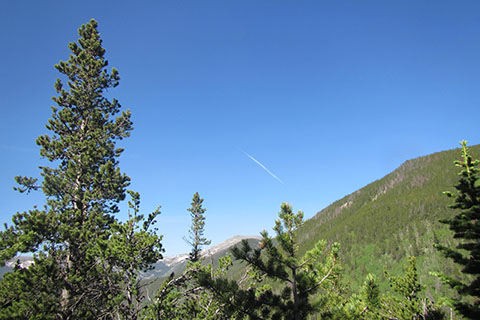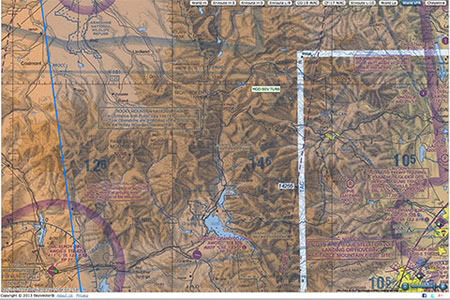| 889 | Summer Stories Contrails |
2013-12-02 |

Contrails over Rocky Mountain National Park
Being in the backcountry of a National Park is a chance to visit wilderness lands. It is an opportunity to re-connect with the earth. We can see the wildlife, marvel at the fields of flowers, feel the breeze, drink the water, gaze at the stars, and experience all things that make up the natural world.
Suddenly, a vapor trail crosses the sky and then another. The Park is in the approach path of a nearby airport. It is not as if the contrail ruins the view, but, well, it sort of does.
In the summer of 2013, while we were in the Mummy Region of Rocky Mountain National Park (Colorado) we must have been near the approach to the Denver airport. Jet after jet crossed the sky. Their contrails laid streaks across the otherwise perfect view. The streaks were frequent enough that we both noticed the interruption. So why are they allowed to fly over the Parks???
The problem is not a simple one. For example, the view from the summit of Longs Peak, on a clear day, stretches for over a hundred miles! Most of that view shed is not a part of the 415 square mile Rocky Mountain National Park. Flights that are not within the Parks boundaries are still visible from within the Park.
To make matters even more complicated in Grand Teton National Park, the airport is in the Park. The Park gets a steady flow of income from allowing aircraft to land on the southeastern edge of the boundary. From the lofty summits of the Tetons, it is possible to see jets approaching their landing to the airport. It is actually a very odd sight.
So for a few Contrail notes ...
The FAA (Federal Aviation Administration) controls the air space over the Parks - as well as the rest of the US land.
There are many different classifications of aircraft, from commercial jet to tour flights to military, etc. The restrictive airspace is not the same for all aircraft.
There are also many classifications of sites managed by the National Park System. Included are the National Parks (natural areas) National Monuments, National Historic Sites, Battlefields, Recreation Areas, Parkways, Rivers, Seashores, Lakeshores, and Trails (and I am sure I left some out).
Noise from aircraft may also be an annoyance. However, noise from motor vehicles (including motorcycles) are also very annoying.
Sightseeing tour flights (Air Tours) are restricted in most National Parks. For example, in Grand Canyon the flights are restricted, but in neighboring Federal Lands they are allowed. Tourists can buzz the Canyon, just not the parts within the National Park.
As we think about our hiking style - wearing Goretex jackets, carrying a GPS, balancing with titanium trekking poles, looking through polarized lenses, and eating freeze dried ice cream - then the contrails do not seem quite so invasive.
A possible solution is to develop or adapt engines for aircraft that do not leave contrails.

SkyVector.com Chart
So if we want a true wilderness experience, we might just have to go somewhere off the beaten path. In other words, find a place where planes don't fly!
Happy Contrail trails
